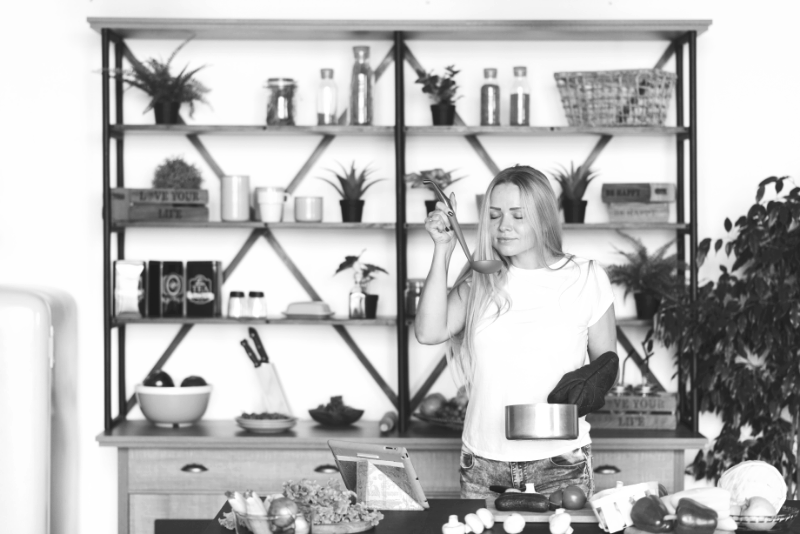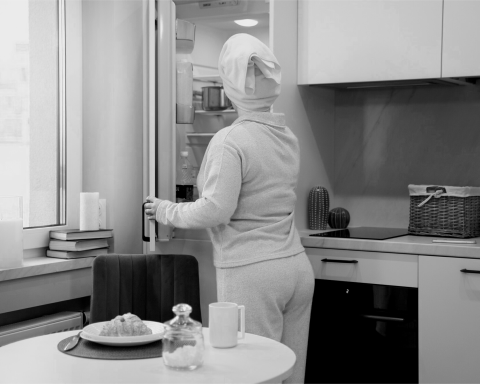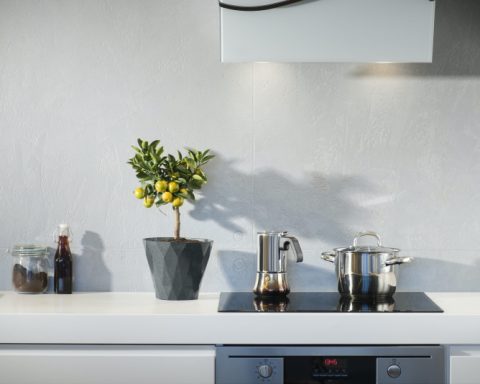Have you ever seen a cooking show or YouTube video? Have you ever observed that the kitchen area where the chef cooks looks very neat, allowing him/her to move swiftly without obstruction?
You might even feel more at home watching tutorials from the chef rather than spending too long in your own kitchen because it is very messy. Cooking utensils are lying around haphazardly, spice containers are scattered in all corners, and your feet often bump into furniture.
That’s why it’s important to organize your kitchen space. A neat space adds beauty to your home and even increases your comfort when cooking and enjoying your meals. However, creating a calm and functional kitchen might be daunting. A cluttered kitchen already makes you feel lazy just to look at it.
Therefore, it is a perfect time to read this article, which will guide you through the key elements of creating an efficient and serene kitchen space. From optimizing layout and maximizing natural light to choosing soothing colors, making some small tweaks can have a big impact. By following these tips, you can start your journey to transform your cooking space into a calm and functional haven.
Challenges in optimizing your kitchen space
Many factors can challenge you to achieve your dream of designing a functional kitchen. The kitchen is a small, busy area that acts like the heart of your home. Thus, this room is quite prone to clutter due to poor layout and limited space. Things will be more complicated if your kitchen has inadequate lighting.
Those issues turn cooking and dining in the kitchen into tiring activities. A cluttered and inefficient kitchen layout makes meal preparation stressful and lengthy. For example, you need more time to figure out where you put your salt because your kitchen has insufficient storage space, which makes things easily scattered. Also, poor layout and obstructions make it more difficult to move around swiftly.
More than that, a chaotic kitchen is prone to getting dirty from oil or water splashes, and it’s difficult to clean the surface. This will make your kitchen unhygienic for preparing meals and dining due to increased cross-contamination among food materials and utensils. Thus, it can disrupt food safety and endanger your health.
To free yourself from this chaotic situation, you can start by taking small steps for improvement. Addressing these challenges creates a beautiful kitchen that enhances daily routines and fosters a sense of calm and order.
Designing for calmness and functionality
Taking actionable steps to create a beautiful and functional kitchen enhances your daily life by accommodating a wide range of physical needs. By considering factors such as ease of reaching, bending, agility, and vision, this beautiful kitchen designs ensure that meal preparation can be performed safely and efficiently.
Therefore, you can learn to achieve a stunning kitchen organization by following these tips:
Optimal layout and flow
Arranging your kitchen area to fulfill the ergonomic requirements helps make your space a perfect, functional kitchen.
One ergonomic requirement for a kitchen you can consider is a “triangle” layout, with space for refrigerator or countertops, space for the stove and cooking appliances, and space for the sink. By minimizing the distance between each area, you can reduce the amount of walking needed while cooking. This makes meal preparation faster and less tiring.
Read more: The Vital Role of Ergonomic Furniture in Modern Living Spaces
Designated activity zones
After you arrange your kitchen to follow the triangle layout, it is time to assemble designated activity zones to achieve beautiful kitchen designs without sacrificing functionality. You need to incorporate your cooking routines while assembling activity zones by following the triangle layout, such as prepping, cooking, and cleaning.
Prepping zone
This zone should be placed between the refrigerator and the sink. It provides ample countertop space for chopping, mixing, and assembling dishes, along with storage for knives, cutting boards, and frequently used utensils. Ensure that small appliances like blenders, which are used daily, are within easy reach.
Cooking zone
This zone should be centered around the stove or cooktop and located near the prep zone to facilitate a flow for easy transfer of ingredients.
This area should have sufficient space on both sides of the stove for placing pots, pans, and ingredients, along with storage for cookware, spices, and utensils. Place frequently used items like spatulas and ladles within your arm’s reach, and you can consider installing shelves or racks for pots and pans.
Cleaning zone
This zone should be located around the sink and dishwasher, situated close to the prep and cooking zones.
You need to ensure that this area has ample space for stacking dirty dishes and drying clean ones and storage for cleaning supplies, dish soap, and dishwasher detergent. You can place the garbage disposal near the sink for easy waste management and store dish towels, drying racks, and cleaning tools in nearby cabinets or drawers.
Read more: 5 Common Mistakes in Organizing the Kitchen and How to Fix Them
Natural light
Nice kitchen designs incorporate natural light. Maximizing natural light in your kitchen improves your visibility, making tasks like cooking and cleaning safer and more efficient while reducing the need for artificial lighting during the daytime.
Sunlight also creates a sense of spaciousness, making the kitchen feel larger and more open. By illuminating the entire room evenly and reducing shadows, natural light minimizes visual barriers and creates a seamless flow from one area to another. Especially if you have limited kitchen space, playing with natural lighting minimizes your feeling of being trapped in a small kitchen.
To maximize natural light in your kitchen, you can try to adopt these practical tips.
- Manipulate with reflective surfaces. Use decorative mirrors or glass tiles to distribute sunlight more evenly throughout your kitchen. Painting cabinets with gloss paint and choosing light-colored countertops further amplifies this effect.
- Add skylights or solar tubes. If you want to make a small change to your kitchen, consider installing a skylight to provide overhead light during daylight hours. Another option is to install solar tubes, which are tubular daylighting devices that effectively increase natural light in your kitchen where windows or skylights aren’t feasible.
- Window treatments. If you have windows in your kitchen, you can cover them with sheer or light-colored curtains. Hanging curtains for your windows is beneficial because they allow you to adjust the lighting level accordingly while establishing your privacy.
Artificial light
In creating a pretty kitchen, you can’t miss the opportunity to incorporate artificial lighting. While natural light is important to enlighten your kitchen during the daytime, artificial lighting has its role during night hours. For incorporating artificial light in the kitchen area, you need to consider two main things as follows.
- Color temperature. Install ambient lighting for the kitchen by considering its placement based on activity zones. As the kitchen is categorized as a work area where you prepare meals, you need to use lighting with cool color temperature (4000-6500 Kelvin).
- Light intensity. Ensure your kitchen has higher illumination levels of task lighting to support you in doing several daily tasks. It is recommended to use higher levels (750-1000 lux) lighting so you can perform some detailed tasks, such as chopping vegetables or plating.
Read more: A Sky Full of Glow: The State of Global Light Pollution and How to Reduce It
Soothing colors
Do you know that colors can significantly influence your emotions, perceptions, and the overall atmosphere of the space? Therefore, it is important to be mindful and consider what moods you want to create in your kitchen before selecting your color palette.
It is recommended to select soothing color palettes to evoke calmness and balance in the kitchen, as you already chose higher lighting intensities. Here are some color recommendations for you that can work in your kitchen according to the atmosphere you want to create.
- Soft yellow. Helps you to create a cheerful and energetic atmosphere.
- Greens or earth tones. Offers a calming and natural feel, promoting relaxation and a connection to nature.
- Soft blues. Provides a serene and clean ambiance, ideal for creating a sense of order and tranquility.
Natural elements
Humans have a strong connection to nature, which is why it is recommended to add various plants around your home so you can have a place to interact with nature. When organizing your kitchen, you can add a natural touch by adding indoor plants or flower arrangements.
You can start decorating your kitchen by placing potted herbs (e.g., basil, rosemary, and mint) on windowsills or countertops. Those plants not only add a touch of greenery but can also provide fresh ingredients for cooking.
Another tip is to consider incorporating natural materials into your furniture, such as wooden shelves, stone countertops, and bamboo utensils, to reinforce your connection with nature.
Read more: Form Meets Function: The Essential Guide to Balanced Home Decor
Smart storage solutions
As you already know, the kitchen is prone to getting cluttered because this area serves a multifunctional purpose for preparing meals, dishwashing, and even dining. That’s why you need to implement smart storage solutions to make this space free from any clutter, so you will not spend much time finding your seasoning or plate.
To create an amazing, neatly organized kitchen, you can try adopting these smart storage solutions to give your seasonings and utensils a home:
- Use drawer dividers. Consider investing in adjustable or customizable drawer dividers to keep utensils, cutlery, and small tools neatly organized. Grouping similar items, such as spatulas, spoons, and knives, makes it easier to find what you need quickly and keeps your drawers tidy.
- Use clear and stackable containers. To maximize space efficiency — especially if you have a small kitchen — use clear and stackable containers that are uniformly shaped. Label each container clearly to identify contents quickly, maintaining both organization and ease of use.
- Utilize mounted shelves. You can consider installing shelves on unused wall space for spices, oils, or decorative kitchenware, and use magnetic strips for metal tools like knives and scissors to save drawer space and keep tools within easy reach.
In conclusion
A cluttered kitchen makes moving around freely in your cooking space difficult and even increases the risk of injury. Also, when your kitchen is messy, it can be difficult to find what you need, leading to wasted time searching for ingredients, utensils, or appliances. This can make you feel frustrated in your meal-prepping activities.
Transforming your kitchen into an organized, efficient, and serene space is more attainable than you might think. By optimizing your layout, creating designated activity zones, maximizing natural and artificial light, choosing soothing colors, incorporating natural elements, and implementing smart storage solutions, you can overcome the challenges of a cluttered and chaotic kitchen.
Don’t let a messy kitchen hinder your culinary creativity and enjoyment any longer. Start implementing these tips today and create a kitchen you love spending time in. Begin your journey towards a functional and tranquil kitchen now, and discover the joy of cooking in a space that is designed to meet your needs and reflect your style.
If you would like to see more resources on kitchen organization, check out the Home Organization Science Labs. The lab uses the research of the Institute for Life Management Science to produce courses, certifications, podcasts, videos, and other tools. Visit the Home Organization Science Labs today.
Photo by Freepik




